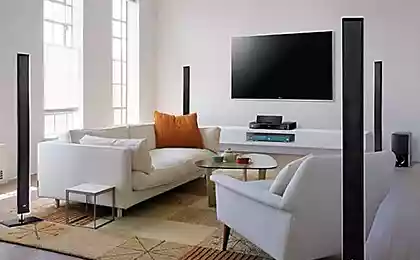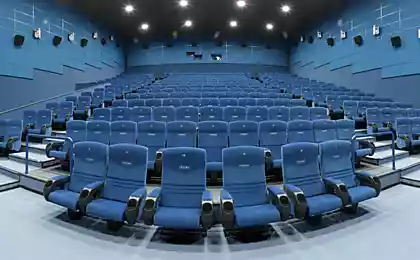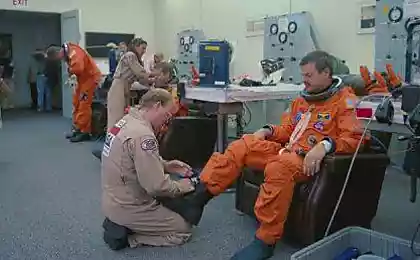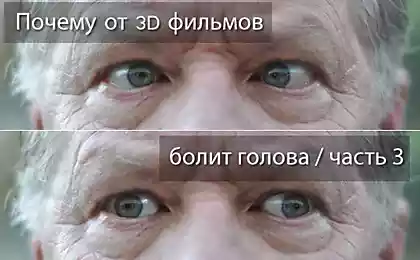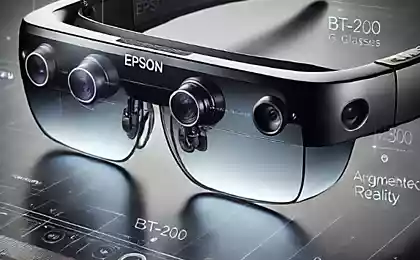Why have a headache from 3D / Part 4 Parallax

This article - the fourth in a series of "Why 3D from a headache." Earlier we talked about problems cinemachinery , was made brief overview of the problems of content , and thoroughly investigate the situation with, perhaps, the most painful problem - confused angles . Continue to fulfill their promises and tell more about what was briefly proanonsirovat earlier. Today there are answers to the questions: Why are the same three-dimensional film in the cinema and on TV does not have? What bands do change the apparent depth of the movie? How does the average depth of the visible films over the years? What can you do if you're sitting in a movie theater, the film "rather flat", and you want more apparent depth? You can do to change the apparent depth and make a "flat" film "is more three-dimensional"? It's so desirable! And finally, as the "alter parallax" TVs and players?
Perception parallax
So, we have two images that we more or less painlessly (see. first part ) show for the right and left eyes. The relative shift of the object from the middle position on the screen in the right eye to the right and the left - the left is called positive parallax (from the Greek "parallaksis") and is perceived as caring for the plane of the screen:

At some point, when you delete an object visible rays coming from his eyes, and become parallel to the object will be perceived as being at infinity:

If the distance between two points on the screen there will be more, the rays diverge and there will be relatively uncomfortable situation:

Obviously, when the same content is at what angle the beams diverge, depending on the size of the screen, the distance to it, and the distance between the eyes of the viewer. For convenience of calculations made to measure the parallax of a percentage of the screen size. Comfortable for film content is considered positive parallax of 1%. Screen width 6.5 meters 1% means a shift of 6.5 inches, which is about the distance between the eyes and, accordingly, "seemingly endless".
In real 3D films found positive parallax to 16%, for example, in "Journey To The Center of The Earth", he comes to 16.56%, in the "Dark Country" - 9.40%, in the "Dolphins and Whales 3D: Tribes of the Ocean" - 8.26%. Take for simplicity parallax 10%, which corresponds to the width of the screen 6, 5 to 65 meters shift centimeters. This is 10 times greater than the average distance between the eyes. Can you remember school geometry and depending on the distance to the screen independently calculate how much you will disperse in different directions eye or may be ironic to note how "on infinity" is the object on the screen, depending on your location in the hall.

Fortunately, the human binocular vision has a lot of reserves, including compensation for this discrepancy. Many people are able to more or less voltage to breed eyes in different directions and thus to perceive three-dimensional image. The correct term for this ability (if anyone interested to dig deeper) - "horizontal fusional reserves." The problem is that these reserves are individual, and, in general, almost all people at a dilution of pictures at some point, there is discomfort, and the picture "splits".
This problem is because the screen that people look 3D, different sizes. If you watch the movie "with a big dip" in the room with a huge screen and the screen closely spaced seats (who learned description IMAX?), Then the There are quite stringent requirements on the content, which can be demonstrated on such screens
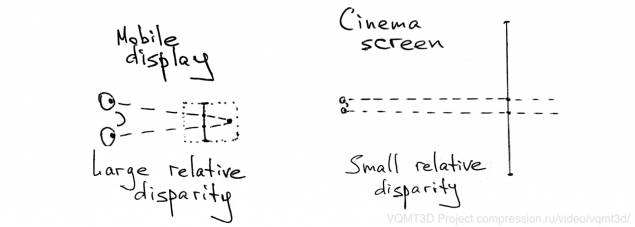
As an example of the fact that even the professionals in the film, the first time making a stereo, making the same mistake, we present a fragment of an interview with the supervisor a stereo film "Dark World" (2010) by Paul Bezborodov (in the converted movie was 20 minutes, that is flat scenes were replaced by rare three-dimensional, in theaters the film was as 3D):
"At first, when we had no projector, we otsmatrivat material on the monitor. Wanted to achieve greater depth, and like we have. But when we looked at the last stage of the projector, then horrified: the person turned out stretched with huge noses, sunken eyes - everything was somehow exaggerated and disproportionate. We are fast enough to cope with this problem, because it got a projector, initially suggesting that in order to adequately evaluate the work done, we will have otsmatrivat material in a format as close as possible to the theatrical projection. "
Blockquote> (Источник)
Ie if they had not realized it in time - made pieces to look good on your monitor, but brought to suffering when viewed on a large screen.
If humor - that problem stereo is that the screen size changes, and our distance between the eyes - no! If you could change the distance between the eyes - that man might look comfortable one and the same movie on the screen of any size! Such an arrangement to make, of course, possible, but here people even light glasses do not like, let alone something heavy and complicated ... But ... if you want ...

(For those who do not understand - it was a joke! Well, a double joke! B> i>
Another problem - the children. They have less distance between the eyes, so the same film as compared with adults they see "more three-dimensional." You can, of course, do not let children at the sessions, the distance between the eyes have less certain. This is certainly a creative idea has not yet been implemented largely because children are very well adapted to the problems of the stereo. But in general, feel free to envy the children. Many films that for you "rather flat", for children it is three-dimensional:

The situation is similar for the negative parallax when the object is in front of the screen plane. When the width of the screen 6, 5 meters parallax -1% means the visible object at the half distance from the viewer to the screen, i.e. pretty big departure. Comfortable for the cinema is considered the average value of the order of -0.5%:

As the attentive reader sees, the perceived depth of the object essentially depends on the distance from the screen. So if you're watching from the front row and the film seems to be flat (in some rooms with a small screen multiplex is found naturally), it is often enough seats in the last row, as you begin to see a great amount. Non-obvious for most of the time, you will agree!
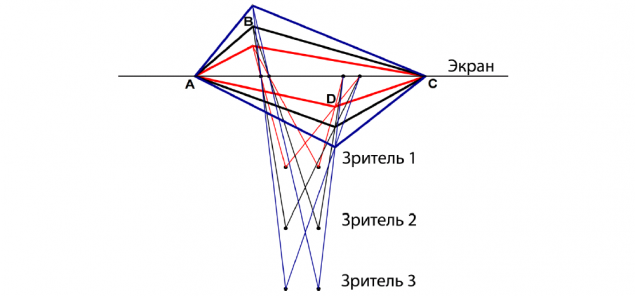
If you remove the screen from the apparent depth of the scene increases in proportion to the distance to the screen, but subjectively: distance "emitted" object from the screen increases proportionally distancing the viewer from the screen, but also the distance from the viewer to the object emitted also increases. B > i>
And, similarly, if you begin to "eye ache" of three-dimensionality of some scenes, you can change seats closer to the screen. True it is desirable to have a more horizontal fusional reserves, as if some objects will be for "infinity", then your eyes will have to separate the sides at a greater angle to consider the background. However, due to the peculiarities of real movies and sizes of real cinema, the first situation is when the movie "rather flat" occurs much more frequently in practice.
The graph below shows the average border zone of positive and negative parallax film competition program of the Moscow stereofestivalya 2014 and, for comparison, the film festivals of previous years:
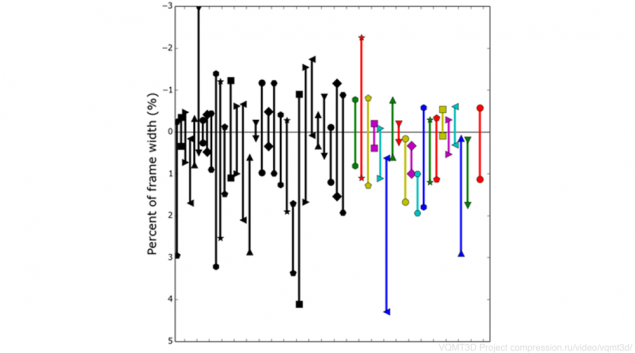
Zero - is the level of the screen. Top - direction to the viewer down - for the screen. On the vertical axis - interest about which mentioned above. In fact, the length of the line - it averaged apparent depth (depth budget) movie scenes. The rightmost red line with circles above and below - the apparent depth, considering for the film "Avatar," which is shown for comparison, as a starting point. At the festival were two rooms: a big and small screens. Films with a depth less than "Avatar" can only be evaluated on a large screen. A movie with a large volume of the depth shown on the small - to save the eyes of spectators.
Let me remind you who collected the most plus comments to the first article in this series (as you can see it has become popular not only you, but I have;): " The film" in Trid "often has a 2-3 stage, where it is the" Trid "noticeably, usually just for this shot and i>". Such feedback is very typical and really often hear from people who watch 3D movies on the screen with a small diagonal (with all). As you can see from the study of drawing, in the competitive program, there are many films, the apparent depth of which is less than that of "Avatar", and sometimes less than 2-3 or even 4 times. These films are absolutely contraindicated watch on the small screen. Only the big screen! You could even say - as large as possible!
At the same time, there are movies (and a lot of them again!), Where we see the depth is greater than the "Avatar", sometimes significantly. I must say, the one who, seeing this, cried out: "Ah-ah-ah-ah! Do not know how to do! "- Will be strongly wrong. Movies with great depth - is often either documentaries intended for 3D TVs, or, for example, educational films made for schools. We have a huge IMAX screens schools with a deep dive for some reason, a rarity, and watch educational 3D movie will be either from the projector on a small screen, or a 3D TV. And the depth was visible - the film must be removed accordingly. And by the way, exactly such films worth watching for those who do not see « Trid i>» Despite a short distance on malipusnye screens. And evaluated in the competition program of such films on the big screen is also contraindicated. There really will stop appearing on such content on the big screen discomfort.
The attentive reader will ask: "Why do some authors have removed all of the screen before the screen or vice versa?". It should be noted that we have this question, too, arises. And the authors we pass. Hopefully, the conclusions they do. Here is a very good picture of the French stereografera Bernard Mendiburu, which marked comfort zone parallax:

Most comfortable for the eyes is the area in the vicinity of the screen and a little behind him - the "green zone". When the distance of the screen as well as in front of it - chances are increasing discomfort when viewing - we see "redness zone". Also note the red area before the screen where the image can only see one eye. They are completely filled with red knowingly, these are the Stereo Window Violation, which were discussed second article (see. Details there) . By the way, one of the problems young authors is that they remove the stereo as shooting 2D, in the end for them, for example, normal planning stage so that the object in it before you get to the center of the frame, there is a conditional "on the right front of the screen ". This causes severe discomfort. Such moments of the category of "How can I make a comfortable 3D?" Quite a lot. We strongly recommend you read the relevant books [1, 2, 3] , we are mainly analyze what happens in the end.
Conclusion:
B> When shooting the film authors choose a range of parallax, which will be laid most of the scenes in order to achieve maximum effect without discomfort on the target screen size. Errors in one direction leads to the appearance of "flat" movies and scenes to another - to a very noticeable discomfort.
The smaller screen size, the smaller the apparent depth (in one and the same content).
In children, due to the smaller distance between the eyes of the image with the same screen is perceived as more "three-dimensional".
If you think a movie screen - try to go on a long series in the cinema hall, with their apparent visual depth increases markedly.
B>
The apparent depth of films
To begin with - again bad news for owners of small screens. As you remember, we have analyzed in detail more than 100 films, released on Blu-ray. The graph below shows the average depth of the visible in all the films with respect to the time axis:
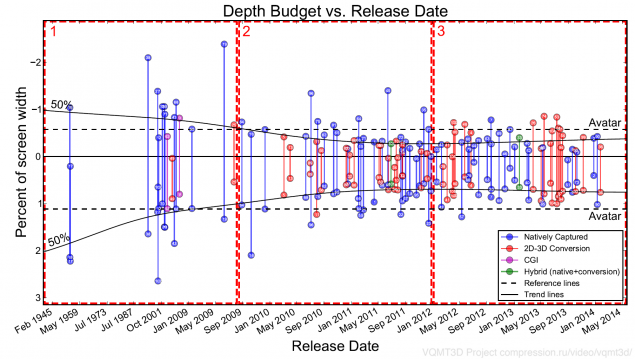
horizontal black dashed line denotes the depth in "Avatar", the solid line - percentage of 50% - the average depth of scenes in movies from time to time (trend line) i>
It is clearly seen that the trend of recent years - to reduce the apparent depth. This means that the depth of these films will be primarily seen well in large-sized screens. Also, there are films which in the apparent depth of 2-2, 5 times less (!) Than "Avatar." In general, it is clear that success "Avatar" in terms of technical quality and in this case, the visual depth is groundless. The audience really saw in "Avatar" depth, which is not the most (!) Shot after the movie. B>
In general, if you sort all the movies on the apparent depth, it turns out, this situation:
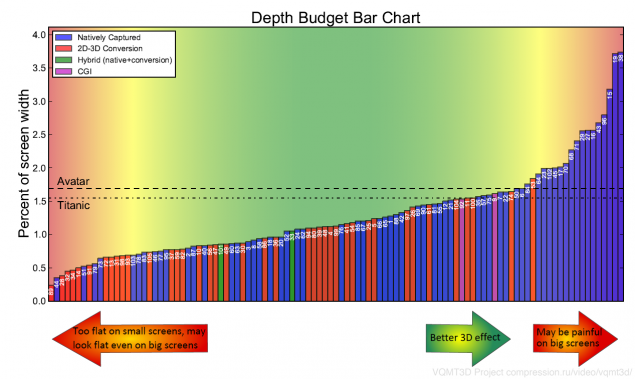
The apparent depth of films - the length of the vertical line from the previous schedule. Red lines - conversion. More to the right, the movie "three-dimensional", the rightmost is better not to look at the big screens i>
It is clearly seen that both the film James Cameron ("Avatar" and "Titanic") relate to the quarter, "the most three-dimensional" among all the analyzed films. Also easy to see that in less visible depth for obvious reasons, "inclined" films produced by the conversion from 2D to 3D, although again - and found the converted movie with excellent depth. And best of "Titanic" only 2 of the film, and worse, "Titanic" for the apparent depth - as much as 38 of converted movie. Taking into account the very high quality conversion from "Titanic", you can say that again, Cameron tried to set the bar for the industry. And at the same time, as usual, be repaid many times at the box office money spent on the conversion to 3D of his old hits.
And another important point to bring the schedule: the apparent depth of the different 3D movies can differ by more than 10 times (!). As not all yogurts are "created equal" and not all the films "the same three-dimensional." Perhaps for some it will be just as unexpected revelation as the fact that the apparent brightness of 3D movies in different rooms of different cinemas may vary up to 10 times (see. The first article).
Above it was a "average temperature in the hospital," ie, an average depth of the visible. But it is obvious that in the movies are "very three-dimensional" and "almost flat" scenes. Below is a balance of 105 films, sorted by the percentage of scenes with little depth. The scale at which thresholds were selected, is shown below the graph.
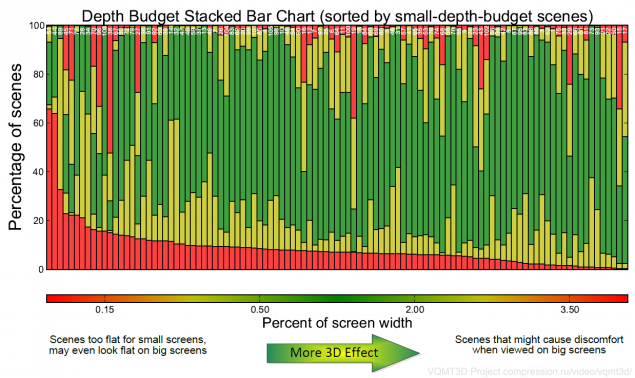
Red bars at the top - the scene with great apparent depth, green - the mean depth, red bottom - visually "flat" scenes. Yellow is an intermediate on both sides. Vertical - the percentage of scenes in the film. Right - the most "honest-dimensional" movies, the left - films with a high degree of planar scenes. The longer the green bar, the (ceteris paribus) comfortable film on the big screen. B> i>
It is clearly seen that, on average, about 10% of the films scenes rather flat. And, as can be seen from the statistics the average of the chart, it is absolutely normal. For example, if you have a scene with mountain panorama without foreground objects, or panorama, taken from a helicopter - it may well be flat, because all is at the maximum parallax. But, of course, a couple of films in which flat scenes more than 50% - this is ... this is definitely the brainchild of marketing and waves of popularity 3D (in parentheses we note both films - low-budget, which cynically earned at a great price of tickets for 3D sessions). It is interesting that there are films in which part of the scene "very three-dimensional," and part of "almost flat", although quite a few of these films, and may be uninteresting, flat on many stages in small screens while diskomfotno-apart three-dimensional scenes big screens, ie conventionally "bad" and there, and there. And it happens.
The same schedule is a good statistically justified response to all owners of 3D laptops.
But this is not enough.
So what?
Ie
And it is clear why.
To be continued!










